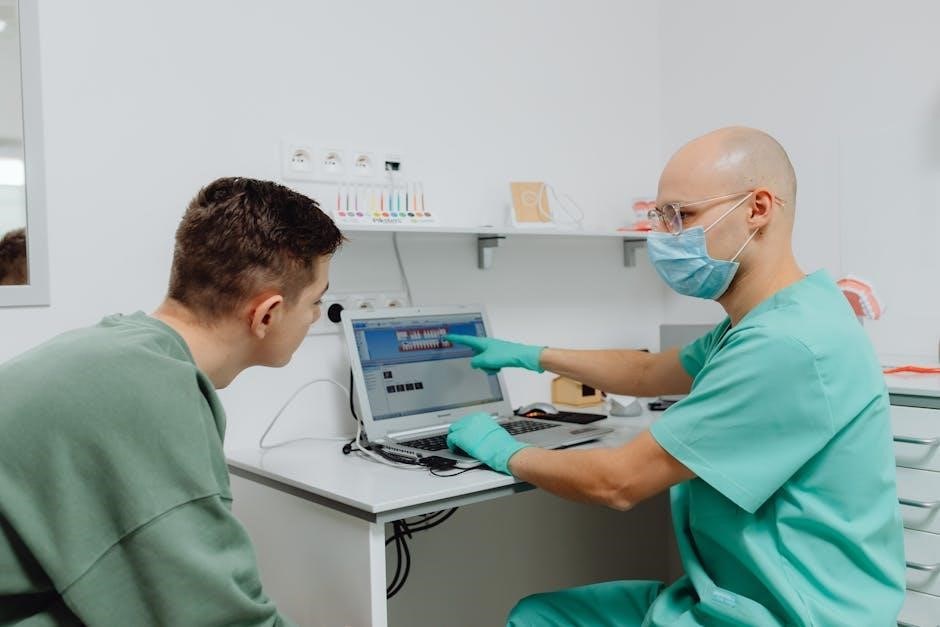The Against Medical Advice (AMA) form is a document where patients request to leave a medical facility against their physician’s advice․ It releases the healthcare provider from liability and acknowledges the patient’s understanding of potential risks․ This form balances patient autonomy with medical guidance‚ ensuring informed decision-making․
Definition and Purpose of the AMA Form
The Against Medical Advice (AMA) form is a legal document used when a patient chooses to leave a medical facility against their healthcare provider’s recommendations․ Its primary purpose is to protect both the patient and the healthcare provider by documenting the patient’s informed decision to leave‚ understanding the associated risks‚ and releasing the facility from liability for potential consequences․ This form ensures clarity and mutual agreement‚ safeguarding both parties and emphasizing patient autonomy while acknowledging the medical team’s advisory role․ It is a critical tool in healthcare settings to manage such situations effectively and ethically․
Importance of the AMA Form in Healthcare
The AMA form is a crucial document in healthcare‚ ensuring patient autonomy while protecting healthcare providers from liability․ It formally records a patient’s decision to leave against medical advice‚ providing legal safeguard for both parties․ This document helps healthcare providers demonstrate that they have informed the patient of potential risks‚ fostering trust and transparency․ By acknowledging the consequences of their decision‚ patients take responsibility for their actions․ The AMA form also aids in maintaining clear communication and accountability‚ ensuring that all parties understand the implications of the patient’s choice to leave against medical recommendations․

Key Components of the Against Medical Advice Form
The AMA form includes patient information‚ declaration of leaving‚ reasons for departure‚ acknowledgment of risks‚ and a liability release statement ensuring clarity and accountability․
Patient Information Section
The Patient Information Section of the AMA form includes essential details such as the patient’s name‚ identification number‚ date‚ and time of discharge․ This section verifies the patient’s identity and provides context for their decision to leave against medical advice․ Accurate completion of this part ensures clarity and accountability‚ making it a foundational element of the form․ It also helps healthcare providers maintain proper documentation for legal and medical records․ This section is critical for establishing the validity of the AMA form and protecting both the patient and healthcare facility․
Declaration of Leaving Against Medical Advice
The Declaration of Leaving Against Medical Advice is a critical section where the patient formally states their intent to depart the facility contrary to medical recommendations․ This part typically includes a clear statement signed by the patient‚ acknowledging their decision to leave without further treatment․ It serves as legal confirmation of the patient’s autonomy and informed choice․ The declaration ensures that the patient understands they are assuming full responsibility for the consequences of their decision‚ thereby protecting the healthcare provider from potential liability․ This section is vital for maintaining ethical standards and legal compliance․
Reasons for Leaving Against Medical Advice
The section detailing reasons for leaving against medical advice outlines the patient’s motivations for departing the facility․ Common reasons include personal circumstances‚ financial constraints‚ dissatisfaction with care‚ or a desire to seek alternative treatment․ This part of the form ensures clarity regarding the patient’s decision‚ helping healthcare providers understand their perspective․ It also serves as documentation that the patient has communicated their rationale‚ which can be crucial for both the patient and the healthcare facility․ This transparency aids in maintaining trust and accountability in the healthcare process․
Acknowledgment of Risks and Consequences
The acknowledgment of risks and consequences section confirms the patient understands the potential harm of leaving against medical advice․ This part of the form outlines the possible health risks‚ such as worsening of the condition or delayed recovery․ The patient acknowledges they have been informed of these dangers and accept responsibility for their decision․ This section is critical as it protects healthcare providers by demonstrating the patient was fully aware of the implications․ It also ensures the patient’s decision is voluntary and informed‚ maintaining legal and ethical standards․
Liability Release Statement
The liability release statement is a critical component of the AMA form‚ where the patient agrees to absolve the healthcare provider and facility from responsibility for any adverse outcomes․ By signing this section‚ the patient acknowledges that they are assuming full liability for their decision to leave against medical advice․ This legal protection ensures healthcare providers are not held accountable for complications that may arise due to the patient’s choice․ The statement reinforces the patient’s understanding of the risks and their voluntary decision to proceed‚ safeguarding both parties legally․ It is a mutual agreement that prevents future claims․

Process of Filling Out the AMA Form
The process involves the patient initiating the request‚ the physician explaining risks‚ and the patient signing the form to confirm their decision to leave against medical advice․
Steps for Patients to Complete the Form
Patients initiate the process by expressing their desire to leave the facility․ They must then review and complete the AMA form‚ providing personal details and reasons for leaving․ Patients acknowledge the risks and consequences of their decision by signing the form․ A witness‚ often a healthcare provider or interpreter‚ verifies the patient’s understanding and voluntary consent․ The form is then submitted to the medical facility‚ ensuring documentation of the patient’s autonomous decision․ This process ensures clarity and protects both the patient and healthcare providers․
Physician’s Role in Completing the Form
The physician plays a critical role in the AMA form process․ They must explain the medical risks associated with the patient’s decision to leave against advice․ This includes discussing potential harm and ensuring the patient understands the consequences․ The physician then acknowledges the patient’s decision in writing‚ confirming that the risks have been communicated․ They also sign the form‚ verifying that the patient’s choice is voluntary and informed․ This step ensures transparency and protects both the patient and the healthcare provider‚ maintaining trust in the healthcare process․
Witness or Interpreter Acknowledgment
The AMA form often requires a witness or interpreter acknowledgment to ensure the patient fully understands the implications of their decision․ If the patient is not fluent in the local language‚ an interpreter must be present to translate the risks and consequences․ The interpreter’s role is to confirm that the patient comprehends the information provided․ This acknowledgment is crucial for validating the patient’s informed consent and ensuring the process is legally sound․ The witness or interpreter signs the form‚ verifying that the patient’s decision was made knowingly and voluntarily․ This step protects both the patient and the healthcare provider․

Legal Implications of the AMA Form
The AMA form provides legal protection for healthcare providers by releasing them from liability for the patient’s decision to leave against medical advice․ It ensures the patient assumes full responsibility for the risks and consequences of their choice․ This document safeguards both parties‚ ensuring clarity and understanding of the legal ramifications involved in such decisions․
Liability Protection for Healthcare Providers
The AMA form offers legal protection to healthcare providers by releasing them from liability for the patient’s decision to leave against medical advice․ This document ensures that providers are not held accountable for any adverse outcomes resulting from the patient’s choice to refuse treatment․ By signing the form‚ the patient acknowledges the risks and absolves the healthcare facility and staff from any legal responsibility․ This liability protection is crucial for maintaining trust and ensuring that medical professionals can operate without fear of unwarranted legal consequences․ It also emphasizes the importance of informed consent and patient autonomy in healthcare decisions․
Legal Consequences for Patients
When a patient leaves a medical facility against medical advice‚ they assume full legal responsibility for any negative outcomes resulting from their decision․ By signing the AMA form‚ the patient acknowledges that they are aware of the potential risks and consequences of leaving without treatment․ This legally binds the patient‚ absolving the healthcare provider from liability․ Patients who leave AMA may face legal repercussions if their decision leads to avoidable harm‚ as they are deemed to have made an informed choice against professional medical guidance․ This underscores the importance of understanding the implications before signing such a document․

The Role of Healthcare Providers
Healthcare providers ensure patients understand the risks of leaving AMA‚ obtain informed consent‚ and document the decision accurately‚ facilitating the process while upholding legal standards․
Explaining Risks to the Patient
Healthcare providers must clearly explain the potential risks and consequences of leaving against medical advice․ This includes discussing untreated conditions‚ possible worsening of symptoms‚ and decreased chances of recovery․ Providers should ensure the patient understands the seriousness of their decision and the medical implications involved․ Effective communication is crucial to confirm the patient’s comprehension and voluntary consent․ This step protects both the patient and the healthcare facility‚ ensuring the decision is informed and documented properly in the AMA form․
Documenting the Patient’s Decision
Documenting the patient’s decision to leave against medical advice involves completing the AMA form thoroughly․ This includes the patient’s acknowledgment of risks‚ their voluntary consent to leave‚ and a liability release statement․ The form must be signed by the patient and a witness‚ if required‚ and include details such as the patient’s name‚ date‚ and time of discharge․ The physician must also verify that the patient understood the risks and consequences of their decision․ This documentation ensures clarity and provides legal protection for both the patient and healthcare providers‚ serving as a formal record of the patient’s informed choice․

Patient Rights and Responsibilities
Patient rights include autonomy to make decisions‚ while responsibilities involve understanding the implications of leaving against medical advice․ Patients must ensure informed choices align with their care needs․
Understanding Patient Autonomy
Patient autonomy is a fundamental principle in healthcare‚ granting individuals the right to make informed decisions about their medical care․ The AMA form respects this autonomy‚ allowing patients to leave a facility despite medical advice․ It ensures that patients’ independence and self-determination are honored‚ even when their choices may contradict professional recommendations․ This balance underscores the ethical obligation of healthcare providers to respect patients’ decisions while ensuring they are fully informed of potential risks․ Autonomy is central to patient-centered care‚ emphasizing the patient’s freedom to choose their own path‚ even when it involves leaving against medical advice․
Patient’s Responsibility in Decision-Making
Patient’s Responsibility in Decision-Making involves acknowledging the consequences of leaving against medical advice․ By signing the AMA form‚ patients confirm they understand the risks and accept accountability for their choice․ This reflects a balance between autonomy and accountability‚ ensuring patients are fully informed and willing to accept the outcomes of their decisions․ The form emphasizes the patient’s duty to consider medical advice while making independent choices‚ highlighting the importance of informed consent and personal responsibility in healthcare decisions․

Consequences of Leaving Against Medical Advice
Leaving against medical advice can lead to untreated conditions worsening‚ increased health risks‚ and higher likelihood of complications․ Patients may face financial penalties and reduced insurance coverage․
Health Risks Associated with AMA Discharge
Leaving against medical advice poses significant health risks‚ as untreated conditions may worsen‚ leading to severe complications․ Patients may experience delayed recovery‚ increased likelihood of infections‚ or progression of chronic diseases․ Without proper treatment‚ symptoms can escalate‚ requiring more intensive care later․ In some cases‚ premature discharge can result in life-threatening outcomes‚ especially for critical conditions․ Continuing care ensures better management of health issues‚ while abandoning treatment can jeopardize long-term well-being․ The AMA form emphasizes these risks‚ ensuring patients understand the potential harm of their decision․
Financial Implications for Patients
Leaving against medical advice can result in significant financial consequences for patients․ Insurance companies may deny claims for treatments related to complications arising from premature discharge․ Patients may incur additional costs for future medical care due to untreated or worsening conditions․ In some cases‚ patients may be held responsible for paying out-of-pocket for subsequent treatments․ The financial burden can escalate if further hospitalization or advanced therapies are required․ Understanding these implications is crucial for patients considering discharge against medical advice‚ as it may lead to unreimbursed medical expenses and long-term financial strain․

Special Considerations
Special considerations in AMA cases often involve minors‚ emergencies‚ or incapacitated patients‚ requiring careful handling to respect patient autonomy while ensuring legal and ethical standards are upheld․
Minors and Incapacitated Patients
Handling AMA cases involving minors or incapacitated patients requires additional legal and ethical considerations․ Minors typically need parental or guardian consent to leave AMA‚ as they cannot legally make such decisions independently․ For incapacitated patients‚ such as those with cognitive impairments or unconscious individuals‚ the process often involves court-appointed representatives or advanced directives․ Healthcare providers must balance respecting patient autonomy with ensuring the patient’s best interests are protected․ Specific legal protocols must be followed to avoid liability and ensure compliance with ethical standards in such sensitive situations․
Emergency Situations and AMA
In emergency situations‚ the AMA process may be expedited due to the urgent nature of care․ Patients leaving against medical advice in emergencies often face higher risks‚ as immediate stabilization might be incomplete․ However‚ hospitals must still ensure the patient understands the potential consequences and documents their decision․ Emergency AMA cases require clear communication and rapid assessment to balance timely discharge with patient safety․ Providers must adhere to legal and ethical guidelines‚ even under time constraints‚ to protect both the patient and the institution from liability․

Ethical Considerations
Ethical considerations involve balancing patient autonomy with medical advice‚ ensuring informed decisions and respecting the right to refuse treatment‚ while upholding provider responsibilities․
Balancing Patient Autonomy and Medical Advice
The Against Medical Advice (AMA) form reflects the ethical balance between patient autonomy and medical guidance․ Patients have the right to make decisions about their care‚ even if it means leaving against medical advice․ Healthcare providers must respect this autonomy while ensuring patients are fully informed about the potential risks and consequences of their decision․ The AMA form serves as both a legal and ethical document‚ protecting providers while acknowledging the patient’s voluntary choice․ This balance ensures that patients are empowered to make decisions aligning with their personal values and preferences‚ even when it contradicts medical recommendations․
Ethical Dilemmas in AMA Cases
Ethical dilemmas arise when patients choose to leave against medical advice‚ creating tension between respecting patient autonomy and ensuring their well-being․ Providers must balance their duty to provide care with the patient’s right to self-determination․ Situations involving minors‚ incapacitated individuals‚ or those with limited understanding of risks intensify these dilemmas․ The AMA form serves as a safeguard‚ documenting the patient’s informed decision․ However‚ concerns persist about whether patients fully grasp the consequences of their choices‚ particularly in high-stakes medical scenarios․ This ethical conflict underscores the complexity of upholding patient rights while mitigating potential harm․

Resources for Patients and Families
Patient resources include access to AMA forms online‚ hospital websites‚ and support services․ Families can find guidance through healthcare providers and counseling programs designed to assist decision-making․
Where to Find AMA Forms
AMA forms are typically available on hospital websites‚ patient portals‚ or at facility administrative offices․ Patients can also request them directly from healthcare providers or hospital staff․ Many medical institutions provide downloadable PDF versions of the form for convenience․ Additionally‚ some pharmacies and clinics offer access to AMA forms for specific situations․ It is essential to consult with healthcare providers to ensure the correct form is used and properly completed․ Hospitals often have dedicated resources or departments that assist patients in obtaining and understanding the AMA form․
Support and Counseling Services
Hospitals often provide support and counseling services to patients considering leaving against medical advice․ These services aim to ensure patients make informed decisions and understand the potential risks․ Social workers‚ counselors‚ and patient advocates are available to discuss concerns‚ financial challenges‚ or alternative care options․ Some facilities offer resources to help patients navigate their decision-making process․ Counseling services may also address emotional or psychological factors influencing the patient’s choice․ These support systems are designed to empower patients while ensuring they are fully aware of the implications of their decision․
The AMA form is a crucial document in healthcare‚ ensuring patients make informed decisions while balancing autonomy with medical advice․
The AMA form is essential for documenting a patient’s decision to leave against medical advice‚ ensuring clarity and protecting both parties legally․ It confirms the patient’s understanding of the risks involved and releases healthcare providers from liability․ This document balances patient autonomy with medical guidance‚ providing a clear record of informed decision-making․ By signing‚ patients acknowledge their voluntary choice‚ while providers are safeguarded from potential legal consequences․ The AMA form thus serves as a critical tool in healthcare‚ promoting transparency and accountability in patient care decisions․
Final Thoughts on Patient Decision-Making
Patient decision-making is a cornerstone of healthcare‚ emphasizing autonomy and informed consent․ The AMA form underscores the importance of respecting patients’ rights while ensuring they understand the implications of their choices․ Providers must strike a balance between offering expert advice and honoring patient preferences․ The AMA process fosters accountability and transparency‚ ensuring both parties are aware of the potential consequences․ It highlights the need for clear communication and empathy‚ ultimately supporting patients in making decisions that align with their personal values and priorities‚ even when they choose to leave against medical advice․
